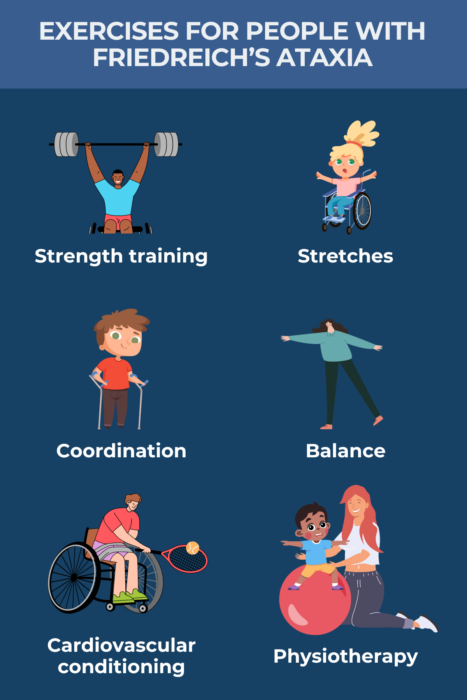Exercise and physiotherapy for Friedreich’s ataxia
Exercise and physical therapy are important for managing the symptoms of Friedreich’s ataxia (FA), and they have been shown to help people with FA improve their overall fitness.
As part of Friedreich’s ataxia treatment, physical therapy may prolong motor function capacity (including the ability to walk) and help achieve a higher quality of life for as long as possible. It can also help reduce pain, abnormalities of the feet and other body areas, and disability caused by this neuromuscular condition.
Any exercises for a child should be done under the guidance of a physical therapist or personal trainer. They also may take place at home, as part of adaptive sports, or at school.
 Find an FA specialist near you
Find an FA specialist near you
Benefits of exercise for people with FA
FA exercise has many benefits, including increased strength and flexibility, better balance and coordination, and improved cardiovascular and bone health.
FA is caused by mutations in the FXN gene, which leads to a deficiency of a protein called frataxin. It is often diagnosed after a child shows symptoms such as problems with coordination, stumbling, falling, and slurred speech, although it can be diagnosed in adults later in life. This results from damage to parts of the brain that coordinate movement. These symptoms may worsen as the disease progresses.
FA treatment can include medication, surgery for scoliosis (an abnormal sideways curvature of the spine) and foot deformities, and various complementary therapies including physical therapy.
An exercise program — including which exercises and how often to do them — should be created under the guidance of a healthcare provider, physical therapist, or personal trainer who is familiar with FA. It should be adapted to the person's specific needs and abilities and adjusted as the condition progresses. It also may help with the use of mobility aids and assistive devices.
Frankie Perrazola is a personal trainer based in Southern California who was diagnosed with FA in 2015 and now uses a wheelchair. She knows how FA can affect every part of a person’s life, and how important it is to have physical therapy from a professional familiar with FA.
In 2020, during the pandemic lockdowns, she decided to become a personal trainer because she no longer had access to a gym.
“When a person is diagnosed with FA, they are immediately told to keep moving and go to physical therapy, the gym, etc., with basically no guidance,” she says. “I wasn’t happy with physical therapy and how they coddled me (and were) not really interested in learning about FA or my body and sending me home with a print-out sheet of stretches.”
Exercise can help a person with FA by decreasing fatigue, providing opportunities for social interaction and inclusion (such as organized sports), and improving quality of life.
Perrazola says that she enjoys teaching the proper way to do certain movements and adapting it to the needs of the person she’s training.
She also says that exercise may help in other ways, including:
- decreasing depression and anxiety
- better sleep
- having fewer aches and pains
- improved mental clarity
- feeling accomplished
- having more natural energy
- creating a stronger mind-body connection
- establishing neuroplasticity (the ability of the nervous system to change and adapt in response to new stimuli or conditions)
- becoming more independent.
Safety always should be a priority, and any exercise program should take into account the person's interests and goals. Before starting an exercise program, it is important discuss the health implications with a doctor.
Strengthening exercises
FA physical therapy may include low-intensity strengthening exercises that aim to maintain and strengthen muscle groups, supporting better mobility and posture. It is important to watch for over-fatigue during strength exercises.
Strengthening exercises for the hip and shoulder muscles help maintain posture and functioning of the arms and legs. Lower back and trunk strengthening exercises help to reduce pain caused by scoliosis (curvature of the spine) and maintain trunk control.
Exercises can be done while sitting or standing while supported.
“Needing someone’s assistance to do them correctly is imperative,” says Perrazola.
The exercises she suggests, while keeping most levels of progression in mind, are aimed at strengthening the core, glutes, hamstrings, ankles, and the shoulders and upper body, including:
- banded glute bridge that incorporates the use of a resistance band, beneficial for strengthening the gluteus maximus and improving hip stability
- elevated push-ups, to build upper body strength
- planks, if possible, to build core strength and stability
- calf raises, which help with lower leg stability.
Other strength exercises for people with FA include:
- seated bicep curls using light weights or resistance bands, to strengthen the upper arm muscles
- seated leg presses using resistance bands or a leg press machine, to work quadriceps and hamstrings
- seated rowing using resistance bands or a cable machine, to work the upper back muscles and biceps
- wall push-ups can be done while standing and leaning against a wall, to work the chest muscles and triceps
- leg raises while lying on your back and lifting one leg at a time, to strengthen the leg muscles.
Stretching exercises
Stretching exercises can be incorporated into a person's daily routine to help maintain flexibility and decrease muscle tightness.
For example, stretching the leg muscles and foot arch are important for a person with FA because of possible foot deformities called pes cavus.
Stretching the spine helps relax tightened muscles from scoliosis, while wheelchair users may benefit from stretching hamstrings and hip muscles to prevent contractures (shortening of a muscle).
These types of exercises should be done gently and without force, and not cause pain or discomfort.
Perrazola suggests some different stretching techniques, including:
- figure-four stretches while lying on the back, bending one knee, and crossing the ankle over the opposite knee, forming a figure-four shape
- broom rotations, which use a broomstick or similar object to improve shoulder and upper body mobility.
Other stretching exercises may include:
- neck stretches that gently tilt the head from side to side, forward, and back
- shoulder rolls, which involve moving the shoulders forward and back, and can improve flexibility in the shoulders and upper back
- trunk rotation, while sitting or standing with feet shoulder width apart, with the torso slowly twisting to one side and then the other side.
Coordination exercises (gait training)
Coordination exercises are recommended for people with FA to help them maintain their sense of motion, positioning, and balance (proprioception).
Improving the ability to stand and walk — also known as gait training — should be done under the guidance of a physical therapist to maintain safety in a controlled environment. The exercises should be adapted to the person's ability and modified as needed.
During gait training, people are asked to watch their movement, as it provides feedback to their brain as they work on improving their walking ability.
It may help if a person watches their feet while walking to improve foot placement. Looking into a mirror while doing these exercises can provide visual feedback.
Coordination activities may be incorporated into daily tasks, such as doing crafts, writing, or dancing.
The therapist may use supports to ensure safety during gait training. Rollators are helpful because they glide smoothly and often have a seat for resting. It is important to maintain locomotion and weight bearing on the legs even if it's necessary to rely on a wheelchair for mobility.
Coordination and gait training exercises for people with FA may include:
- heel-to-toe walking with the toes of one foot touching the heel of the other as the person moves forward, to work on balance
- stepping up and down on a small platform, to work on leg strength, balance, and coordination
- going up and down stairs with assistance, if possible
- playing catch with a soft ball to improve hand-eye coordination
- navigating a simple obstacle course laid out with cones or other objects, to improve coordination and agility.

Balance exercises
Balance exercises may help improve or maintain balance and stability when sitting, standing, walking, and moving. It also may reduce the risk of falls.
These exercises should be done under the guidance of a physical therapist or a personal trainer who has knowledge of FA.
Perrazola suggests balance exercises such as standing calf raises, which strengthen the calves and improve lower leg stability.
Other balance exercises for a person with FA may include:
- using a balance or wobble board to practice maintaining balance and stability — a person may need support while standing on the board
- standing on one leg for short periods of time, and gradually increasing the time as balance improves
- sit-to-stand exercise to help a person move from a seated position to standing, while working on balance and coordination.
Adapted yoga or tai chi can be done at home, to help improve balance, flexibility, and overall body awareness. Discuss options for in-person or online classes with a physical therapist.
Conditioning
Conditioning exercises for people with FA aim to boost heart and lung function, overall endurance, and energy levels.
Consult a healthcare professional, such as a physical therapist, about cardiovascular exercises, to ensure the exercises are safe. A physical therapist should monitor heart rate and breathing during exercise.
Some exercises can be done in a healthcare setting, while others may take place at home or at a community center, like with swimming or adapted yoga classes.
Exercises to improve cardiovascular health in people with FA may include:
- stationary cycling
- seated rowing
- swimming and gentle aquatic exercise
- seated aerobics, such as leg lifts and arm movements
- wheelchair pushing at a moderate pace
- adapted dance movements
- adaptive sports, such as wheelchair basketball, wheelchair tennis, and adaptive golf.
Physiotherapy
FA physiotherapy is done by healthcare professionals who specialize in optimizing physical function and mobility. The therapist can play a crucial role in improving quality of life and overall well-being.
Before starting a treatment plan, the physical therapist should conduct a thorough physical evaluation, including an assessment of specific complaints, functional abilities, posture, balance, range of motion, spinal alignment, foot alignment, muscle flexibility and strength, coordination, mobility, gait, endurance, and cardiovascular response to activity.
The physical therapist then will establish an appropriate plan to address the person's specific needs. This can include setting up a home exercise program and teaching strategies that help a person with FA complete daily tasks more efficiently and with less effort.
Friedreich’s Ataxia News is strictly a news and information website about the disease. It does not provide medical advice, diagnosis, or treatment. This content is not intended to be a substitute for professional medical advice, diagnosis, or treatment. Always seek the advice of your physician or other qualified health provider with any questions you may have regarding a medical condition. Never disregard professional medical advice or delay in seeking it because of something you have read on this website.
Recent Posts
- Toward a new understanding of positivity and hope
- New tool tracks hidden symptoms in people with Friedreich’s ataxia
- A gift-giving guide for those who have a loved one with FA
- My FA diagnosis left me ‘thoroughly shaken,’ but I’ve found my resolve
- New MRI approach using AI may offer better picture of FA changes
Related articles

 Fact-checked by
Fact-checked by 



